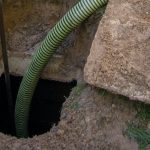To put it simply, yes. You can use garbage grinders & water treatment appliances when on septic.
Garbage grinders are handy for those who spend a lot of time in the kitchen and when you’re living in a rural area, water softeners are often a must. Garbage disposals can discharge to your system if precautionary measures are taken while water softeners should stay far away from your septic.
Let’s put it in terms of the IL State Code. If you’re installing a garbage grinder in your home, you have two options.
1) You must increase the size of your septic tank to 1.5x’s the required size as well as increase the size of your absorption area
or
2) Install a separate kitchen line discharging to a solids retention tank prior to your septic tank and increase the size of your absorption area.
But why? These measures were put in place because garbage grinders put added stress on your system.
Garbage disposals allow unprocessed raw waste to enter the septic tank without having been digested by the human body. This creates a lot of raw matter for the septic tank to break down. The raw waste enters the tank without being accompanied by bacteria generated by the body to help break it down. In addition, using garbage grinders heightens the risk of homeowners mistakenly polluting their systems with FOGs (fats, oils, & greases). Bottom line, garbage grinders aren’t necessarily discouraged by septic professionals, but if you decide to install one, you should increase the frequency of your septic tank cleanings to offset the increased inflow of undigested waste. Not to mention, homeowners need to be especially mindful at the sink (shankssterbros.net).
Moving onto water softeners… Per the Illinois Department of Public Health (2013), water softener backwash cannot discharge to the septic tank.
If you have or will be installing a water softener, the code requires that the backwash water be rerouted around the tank to a separate trench or other approved discharge point. No clear water can be discharged into the septic tank. All furnace, AC, and reverse osmosis must go to the ground surface, natural drainage area, or sump pump. There’s only one way water softener waste can discharge to your tank and that is by installing an NSF/ANSI 44 certified water softener in your home. NSF 44 water softeners are salt-free and, unlike their counterparts, have not demonstrated significant impact to soils absorption properties. Water softener discharges containing salt have been found to cause soil pores to swell, especially in clay soils, in turn decreasing absorption of your household waste. Nevertheless, the size of your absorption area still needs to be increased to accommodate the regeneration cycle. It’s critical that you do not discharge a non-certified NSF/ANSI 44 water softener to your septic tank as it could be detrimental to the life expectancy of your system.
All things considered, you as a responsible homeowner, have to weigh your options to see if the benefit of having a garbage grinder in your kitchen trumps the cost it will add to your septic system design. With water treatment appliances, on the other hand, simply ensure that your lot has enough room for a separate trench, an approved discharge point nearby, or splurge on an NSF/ANSI 44 certified softener.




